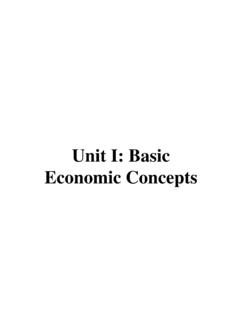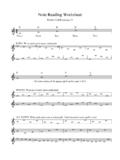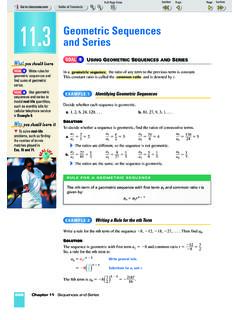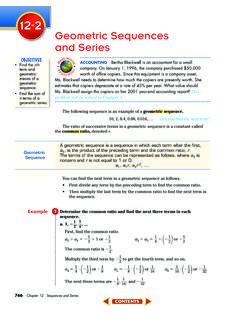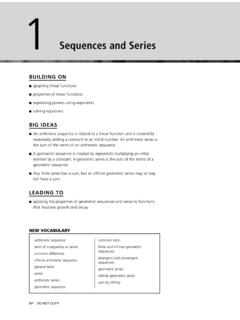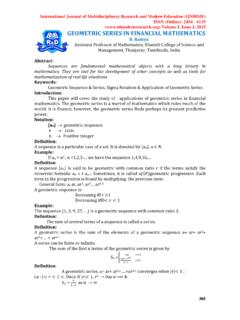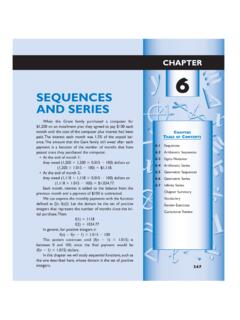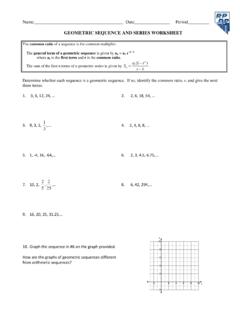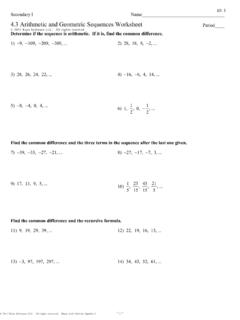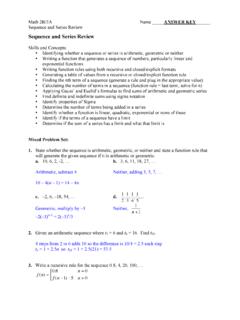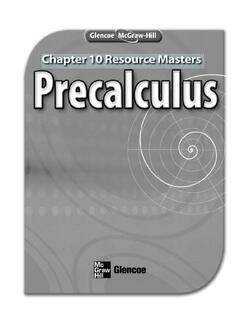Transcription of Chapter 11: Sequences and Series - CVUSD Home
1 618 Unit 4 Discrete MathematicsFocusIncorporate numerical fluency and mathematical tools with discrete 11 Sequences and SeriesEvaluate and manipulate arithmetic and geometric Sequences and the binomial theorem and mathematical 12 Probability and StatisticsUnderstand and use the fundamental counting principle, combinations and permutations in and use the standard 4 Discrete Mathematics 619 Algebra and Social StudiesMath from the Past Emmy Noether was a German-born mathematician and professor who taught in Germany and the United States. She made important contributions in both mathematics and physics. In this project, you will research a mathematician of the past and his or her role in the development of discrete mathematics.
2 Log on to to Stock/Alamy Images620 Chapter 11 Sequences and Series11 Sequences and SeriesSequences and Series Make this Foldable to help you organize your notes. Begin with one sheet of 11 by 17 paper and four sheets of notebook the short sides of the 11 by 17 paper to meet in the the notebook paper in half lengthwise. Insert two sheets of notebook paper under each tab and staple the edges. Take notes under the appropriate i Vi -i i Kaz Chiba/Getty ImagesReal-World LinkChambered Nautilus The spiral formed by the sections of the shell of a chambered nautilus are related to the Fibonacci sequence . The Fibonacci sequence appears in many objects naturally.
3 Standard Students know the binomial theorem and use it to expand binomial expressions that are raised to positive integer powers. (Key) Standard Students apply the method of mathematical induction to prove general statements about the positive integers. Standard Students derive the summation formulas for arithmetic Series and for both finite and infinite geometric Series . (Key)Key Vocabularyarithmetic Series (p. 629) geometric Series (p. 643)inductive hypothesis (p. 670)mathematical induction (p. 670)recursive formula (p. 658)YX"Option 2 Chapter 11 Get Ready For Chapter 11 621 GET READY for Chapter 11 Diagnose Readiness You have two options for checking Prerequisite 1 Take the Quick Check below.
4 Refer to the Quick Review for each equation. (Lesson 1-3) 1. -40 = 10 + 5x 2. 162 = 2 x 4 3. 12 - 3x = 27 4. 3 x 3 + 4 = -20 5. FAI R Jeremy goes to a state fair with $36. The entrance fee is $12 and each ride costs $4. How many rides can Jeremy go on? (Lesson 1-3)Graph each function. (Lesson 2-1) 6. {(1, 1), (2, 3), (3, 5), (4, 7), (5, 9)} 7. {(1, -20), (2, -16), (3, -12), (4, -8), (5, -4)} 8. (1, 64), (2, 16), (3, 4), (4, 1), (5, 1 _ 4 ) 9. (1, 2), (2, 3), (3, 7 _ 2 ) , (4, 15 _ 4 ) , (5, 31 _ 8 ) 10. HOBBIES Arthur has a collection of 21 model cars.
5 He decides to buy 2 more model cars every time he goes to the toy store. The function C(t) = 21 + 2t counts the number of model cars C(t) he has after t trips to the toy store. How many model cars will he have after he has been to the toy store 6 times? (Lesson 1-3)Evaluate each expression for the given value(s) of the variable(s). (Lesson 1-1) 11. x + (y 1)z if x = 3, y = 8, and z = 2 12. x _ 2 (y + z) if x = 10, y = 3, and z = 25 13. a b c - 1 if a = 2, b = 1 _ 2 , and c = 7 14. a (1 - bc) 2 _ 1 - b if a = -2, b = 3, and c = 5 EXAMPLE 1 Solve the equation 14 = 2 x 3 + 700. -686 = 2 x 3 Subtract 700 from each side.
6 -343 = x 3 Divide each side by 2. 3 -343 = 3 x 3 Take the cube root of each side. -7 = x 2 Graph the function (1, 1), (2, 1 _ 2 ) , (3, 1 _ 3 ) , (4, 1 _ 4 ) , (5, 1 _ 5 ) .The domain of a function is the set of all possible , the domain of this function is {1, 2, 3, 4, 5}. The range of a function is the set of all possible y-values. So, the rangeof this function is 1, 1 _ 2 , 1 _ 3 , 1 _ 4 , 1 _ 5 .EXAMPLE 3 Evaluate the expression 2 m + k + b if m = 4, k = -5, and b = 1. 2 4 + (-5) + 1 Substitute. = 2 0 Simplify.
7 = 1 Zero Exponent RuleTake the Online Readiness Quiz at {x { n - } i , 622 Chapter 11 Sequences and SeriesSequencesThe numbers in a sequence may not be ordered. For example, the numbers 84, 102, 97, 72, 93, 84, 87, 92, .. are a sequence that represents the number of games won by the Houston Astros each season beginning with Sequences The numbers 3, 4, 5, 6, .., representing the number of shingles in each row, are an example of a sequence of numbers. A sequence is a list of numbers in a particular order. Each number in a sequence is called a term. The first term is symbolized by a 1 , the second term is symbolized by a 2 , and so on.}
8 A sequence can also be thought of as a discrete function whose domain is the set of positive integers over some Sequences have patterns. For example, in the sequence above for the number of shingles, each term can be found by adding 1 to the previous term. A sequence of this type is called an arithmetic sequence . An arithmetic sequence is a sequence in which each term after the first is found by adding a constant, called the common difference, to the previous roofer is nailing shingles to the roof of a house in overlapping rows. There are three shingles in the top row. Since the roof widens from top to bottom, one more shingle is needed in each successive the Next TermsFind the next four terms of the arithmetic sequence 55, 49, 43.
9 Find the common difference d by subtracting two consecutive - 55 = -6 and 43 - 49 = -6 So, d = add -6 to the third term of the sequence , and then continue adding -6 until the next four terms are 37 31 25 19 + (-6) + (-6) + (-6) + (-6)The next four terms of the sequence are 37, 31, 25, and Find the next four terms of the arithmetic sequence , , , .. Arithmetic SequencesRow1234567 Shingles345678911-1 Main Ideas Use arithmetic Sequences . Find arithmetic for Standard Students find the general term and the sums of arithmetic Series and of both finite and infinite geometric Vocabularysequencetermarithmetic sequencecommon differencearithmetic meansLesson 11-1 Arithmetic Sequences 623It is possible to develop a formula for each term of an arithmetic sequence in terms of the first term a 1 and the common difference d.
10 Consider the sequence in Example a 1 a 2 a 3 a 4 .. a n Expressed in Te r ms of d and the First Termnumbers55 + 0(-6)55 + 1(-6)55 + 2(-6)55 + 3(-6) .. 55 + (n - 1)(-6)symbols a 1 + 0 d a 1 + 1 d a 1 + 2 d a 1 + 3 a 1 + (n - 1)dThe following formula generalizes this pattern for any arithmetic can use the formula to find a term in a sequence given the first term and the common difference or given the first term and some successive a Particular TermCONSTRUCTION The table at the right shows typical costs for a construction company to rent a crane for one, two, three, or four months. If the sequence continues, how much would it cost to rent the crane for twelve months?
